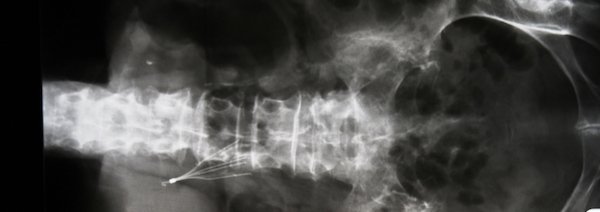Failing to remove inferior vena cava (IVC) filters in a timely and safe way could cause the patient to suffer devastating IVC filter removal complications, injuries and possibly death. Neglected or defective filters may clog or break apart and migrate throughout the body, making it impossible to retrieve and remove the filter at all.
If you have been injured by any type of IVC filter, you may be able to bring an IVC filter lawsuit against the medical manufacturer (such as Bard, Cook, or Boston Scientific). Depending on the case, you may receive a large financial sum to cover all your expenses, including pain and suffering. Click on a filter retrieval technique below to learn more.
- 1. Risks of not removing IVC filters
- 2. Standard removal
- 3. Loop snare technique
- 4. Rigid endobronchial forceps
- 5. Excimer laser sheath-assisted photothermal ablation
- 6. Stiff-wire displacement
- 7. Sling technique
- 8. Sandwich technique
- 9. Telescope sheath technique
- 10. Money damages for your injuries

1. Risks of not removing IVC filters
The FDA has recommended that IVC filters be removed as soon the patient is no longer at risk for blood clots (or if the blood clot is being managed by other therapies). Doctors should even consider removing filters that are designed as permanent implants — such as the Cordis® TRAPEASE® Vena Cava Filter — due to risk of IVC filter complications.1
Defective IVC filters carry several potential problems, including:
- tilting from the intended position
- fracturing into pieces
- traveling throughout the body
- perforating and/or lodging into veins and organs
The sooner doctors remove IVC filters, the less of a chance that the patient will suffer complications. IVC filters become much more difficult to retrieve once they have fractured, become embedded, or traveled. And in some cases, removing a defective filter is either impossible or too risky to the patient’s immediate health.
Note that medical manufactures often sell IVC retrieval kits specifically tailored to their IVC filters. Examples include:
- Snare Retrieval Kit (Bard)
- RECOVERY CONE® Removal System (Bard)
- CloverSnare® 4-Loop Vascular Retriever (Cook Medical)
- Günther Tulip® Vena Cava Filter Retrieval Set (Cook Medical)
If everything goes well, retrieving an IVC filter can be an outpatient procedure where the patient goes home and resumes normal activities quickly. The IVC filter removal recovery time may take only a day or two before the patient can return to work.
But if the patient is suffering from a defective or malpositioned filter, the patient may have to be put under general anesthesia for IVC filter removal. Then depending on how the operation goes, he/she may remain in the hospital indefinitely.
As discussed below, an IVC filter removal surgery can go wrong and make the problem worse. And as with any operation, patients who get their IVC filters removed are susceptible to infection at the incision site and may experience unforeseen complications from the surgery.
Patients who have been injured by IVC filter removal complications — or whose filters are too defective to be removed — may have grounds to bring a lawsuit against the medical manufacturer.
2. Standard Removal
The standard technique for IVC filter retrieval involves using an “endovascular snare device.” This snare literally captures the filter’s hook and collapses the filter into a sheath so the surgeon can disengage the filter from the vein.
The standard technique is most successful when the IVC filter has not moved from its original position, and the IVC filter removal recovery time should be no more than a day or so. This technique is also more likely to fail once seven months have passed since implantation.
3. Loop Snare Technique

The loop snare technique is when the surgeon loops a wire through the IVC filter’s body. Physicians may fall back on this method when the filter has tilted or become embedded.
When a filter is particularly tilted, surgeons may employ a type of loop snare technique called the “hangman”: This is when they pass the wire between the neck of the filter and the inferior vena cava wall.
4. Rigid Endobronchial Forceps
Another method surgeons use to extract tilted IVC filters is by using rigid endobronchial forceps. The forceps may be able to “capture” the filter’s apex (head) when a snare is unable to. Depending on the case, doctors may also use forceps to retrieve fractured struts (the legs of the filter).
Note that the forceps themselves can cause complications if they are misused: Since they are big and curvy, they can lead to caval distension and therefore significant discomfort.
5. Excimer Laser Sheath-Assisted Photothermal Ablation
When a filter’s struts (legs) becomes encased in the patient’s tissue, surgeons may be able to “ablate” this tissue using a laser. The advantage of this technique is that it reduces the amount of force the surgeon would otherwise need to pry the filter free. However, surgeons usually must be able to latch onto the filter’s apex/hook prior to the ablation in order for the removal to be successful.
6. Stiff-wire Displacement

When a filter is too tilted to be retrieved by a standard approach, surgeons may pass a stiff wire between the filter and venal wall in attempt to right the filter’s position. If successful, the surgeon can then use a snare device to engage the filter.
If necessary, the surgeon can also follow the stiff wire with an angioplasty balloon and then inflate it. This “balloon displacement” technique would gently cause the struts to detach from the caval wall and make it possible for the surgeon to remove it.
Stiff-wire displacement is especially suited for conical filters, such as Cook’s Celect model or Boston Scientific’s Greenfield filter™. Note that the stiff-wire technique does carry a risk of making the situation worse, such as causing the filter to fracture or travel.
7. Sling Technique
The sling technique is another method for dislodging embedded filters, especially if they are not the typical conical shape. The surgeon creates a U-shaped “sling” with a guidewire that surrounds the filter. Then the surgeon would tighten the sling in attempt to extract the filter from the caval wall. But as with most techniques, it could potentially make the situation worse.
8. Sandwich Technique
In the sandwich technique, surgeons use wires to engage IVC filters at both ends–the struts and the head. Then once the filter is dislodged, the surgeon can remove the filter from either direction depending on which would be easier.
The sandwich technique can be effective at repositioning filters because the surgeon can manipulate the filter from either end. But it also requires two access points, usually a transjugular vein and a femoral vein. This, in turn, may cause a longer IVC filter removal recovery time.
9. Telescopic Sheath Technique
Like the sandwich technique, the telescopic sheath IVC filter retrieval technique requires dual-access to the filter. If successful, the surgeon would trap the filter into not one but two sheaths — the femoral and jugular — before removing it. This increases the likelihood of removing the entire filter successfully.2
10. Money damages for your injuries
If you are suffering from IVC filter injuries or IVC filter removal complications, you could be eligible for hefty financial damages from the medical manufacturer. This includes compensation for:

- medical bills,
- pain and suffering, and
- lost wages and future earnings
At Shouse Law Group, our personal injury lawyers fight for our clients in all matters of personal injury cases, including defective medical devices. And you pay us zero dollars unless we win your case. Just be sure to act quickly before the IVC filter lawsuit statute of limitations passes.
For a free meeting with our personal injury attorneys, contact us now.
Legal References
- “Notable decrease in IVC filter usage after FDA advisory Significant decrease in inferior vena cava filter implantation following FDA safety communication. implantation rates remain high compared to rates in Europe,” Science Daily (July 10, 2017).
- Kush R. Desai, Mithil B. Pandhi, Stephen M. Seedial, Martin F. Errea, Riad Salem, Robert K. Ryu, Robert J. Lewandowski, “Retrievable IVC Filters: Comprehensive Review of Device-related Complications and Advanced Retrieval Techniques“, Vascular/Interventional Radiology (July 11, 2017); Ramsey Al-Hakim, MD, Justin P. McWilliams, MD, William Derry, MD, andStephen T. Kee, MD, “The Hangman Technique: A Modified Loop SnareTechnique for the Retrieval of Inferior Vena CavaFilters with Embedded Hooks“, JVIR Vol 26 No. 1 (January, 2015); By Kush R. Desai, MD; Robert K. Ryu, MD, FSIR; and Robert J. Lewandowski, MD, FSIR, “Current IVC Filter Retrieval Techniques“, Endovascular Today (July 2017); James L. Laws, BS, Robert J. Lewandowski, MD, Robert K. Ryu, MD, and Kush R. Desai, MD, “Retrieval of Inferior Vena Cava Filters: Technical Considerations“, Semin Intervent Radiol. 2016 Jun; 33(2): 144–148; Gokhan Kuyumcu, and T. Gregory Walker, “Inferior vena cava filter retrievals, standard and novel techniques“, Cardiovasc Diagn Ther. 2016 Dec; 6(6): 642–650.
